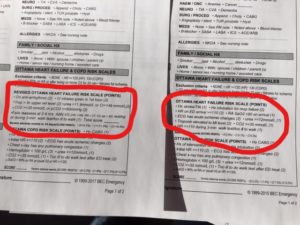Change in the ED. Are you asking the right questions?
Congratulations! You’ve decided you want to bring about change in your healthcare organization. You’re going to bring in an EMR, add some knowledge transfer tools, change workflow, or bring in a new coffee maker. It could be anything!
Here’s the problem: No matter how big or small the change, you can expect resistance. But you know that the change will make things better – for your doctors and nurses, for patients, or for the hospital.

How do you move from idea to implementation?
Understand how and why people change.
Before you can hope to have a new process or system implemented in the ED, it’s important to have an understanding of why people change. There are several frameworks of change, but here’s the one we find most useful:
What this says is that people will adopt something new if they have to, recognize that it’s the best way to do something, and if it fits with how they think things should be done. Of course, in practice the model isn’t quite so simple!
For change in the ED, what we actually see looks more like this:
Order matters.
Knowing the building blocks of successful change is step one. However, how you put these pieces together is just as important as the pieces themselves.
Our approach is start with values and work backwards. This lets us get buy-in from practitioners, and it lets them define how the process would work best for them. What’s amazing is that once nurses and doctors agree on common values, the rest of the change comes together easily!
The BEC Approach
1. Agree on Shared Values
Step 1 focuses on the green circle – value-based decision making.
This most important step of any hospital change process is to build agreement on what you are trying to accomplish as a group. This is not about what you are trying to accomplish with this project, but why you work at the hospital and what the hospital should be striving for.
What to do
The best way to build agreement on values is to sit down and have a discussion during a staff meeting. However, this is often not feasible with a group of shift workers. That’s why we use a combination of meetings and surveys. Our survey template is here.
2. Talk about what changes bring you closer to your step one goal
Step 2 deals with the yellow circle – agree on information.
If your shared values talk about providing the best possible patient care, you need to agree as a group on how to bring this about. In this example, one possible answer might be to ensure that every patient is assessed using accepted evidence-based rules.
You’ll notice this step doesn’t refer to how you as a group would ensure that evidence is used consistently. What’s important is that you get agreement about what’s important to reach your goal.
Again. this step does not explicitly refer to the system or process you want to implement. Before you can get agreement on what or how to implement, you need agreement on what changes are needed.
What to do
A good way to go about agreeing on how to reach your collective goal is to get together as a group (or working group) to brainstorm. The idea is to come up with several feasible options that everyone agrees would work.
For situations where it is difficult to brainstorm in person, we include an applicable section on the template we use when working with emergency departments.
3. Decide how to integrate the necessary changes
Step 3 deals with the red circle – power.
If steps one and two have been completed, this is by far the easiest step of implementing a new system in an emergency department or hospital setting. Once you have agreement from all stakeholders (a) that change is necessary and (b) what activities need to happen to achieve your goal, agree on a system or process that meets these requirements and explain how the system will embed the changes that everyone has agreed are necessary.
What to do
There are two ways to go about deciding how to embed a process: (1) Propose a system and explain how it solves the problem; or (2) Ask for input on what the requirements for the system should be based on your previous exercises then find a solution that meets stakeholders’ criteria. We find that the second approach works best.
Once again, it’s best to do this in person. If that is not feasible, do it remotely via survey. Our simple template lets us collect the information we need.
Example: Implementing Clinical Documentation in a Regional Emergency Department
We recently underwent a process similar to this where we were mostly forced to collect data by way of surveys – although we also met with both working groups and administrators. Here’s a summary of the input we received:
Fortunately for us, this process exactly described our product, but it doesn’t have to. What’s important is that by going through this three step process, the emergency department gets a product that will be useful and used!



 Previous Post
Previous Post Next Post
Next Post

